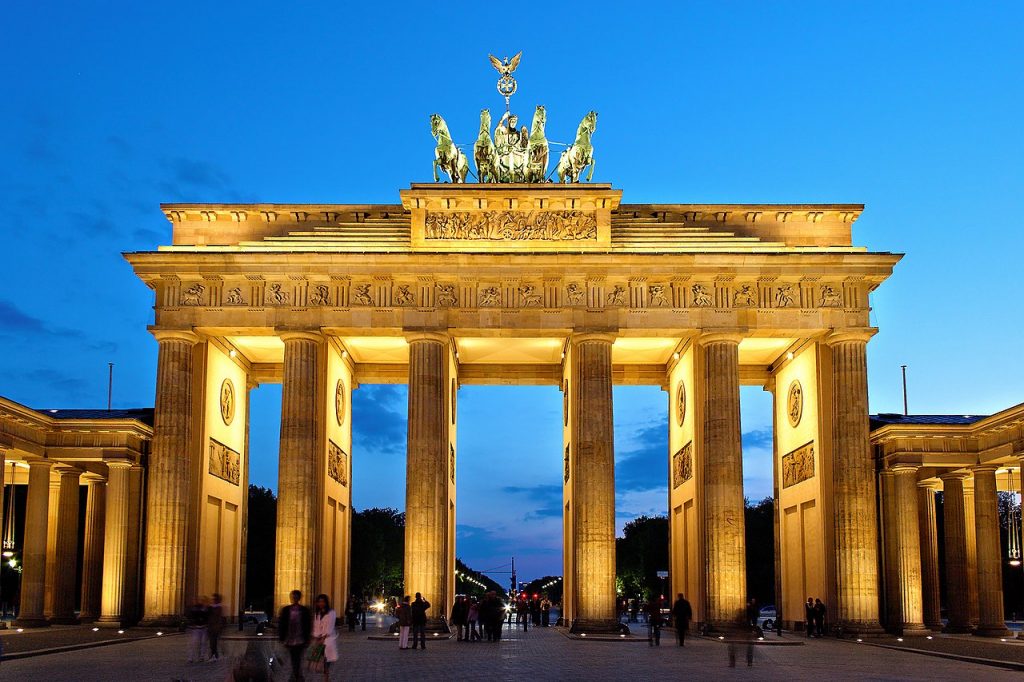
Once again the capital of a unified Germany, Berlin today has the largest Jewish community in the country (11 000 people). This is nonetheless far fewer than the some 170 000 Jews who lived here just before Hitler’s rise to power in 1933. One can well imagine that the ghosts of history will wander in Berlin for a long time to come, a city that, like Vienna, was a major economic, intellectual, and religious center for German Jews. Some monuments and cemeteries (notably the Weissensee, the largest Jewish cemetery in Europe) escaped Nazi destruction and the Allied bombings of 1945. The willingness of the new Germany to accept the totality of its heritage, including its most somber and shameful episodes, and to deliver its mea culpa for the horrors committed in the name of the German people, is the source of efforts to build or rebuild synagogues, community centers, schools, and memorials in all areas of the city today.
The duty of remembrance
The fall of the Berlin Wall in 1989 permitted the reconstruction of part of the old Jewish quarter of Orianienburgerstrasse. The Jewish Museum of Berlin , designed by architect Daniel Libeskind, was opened in 1999.
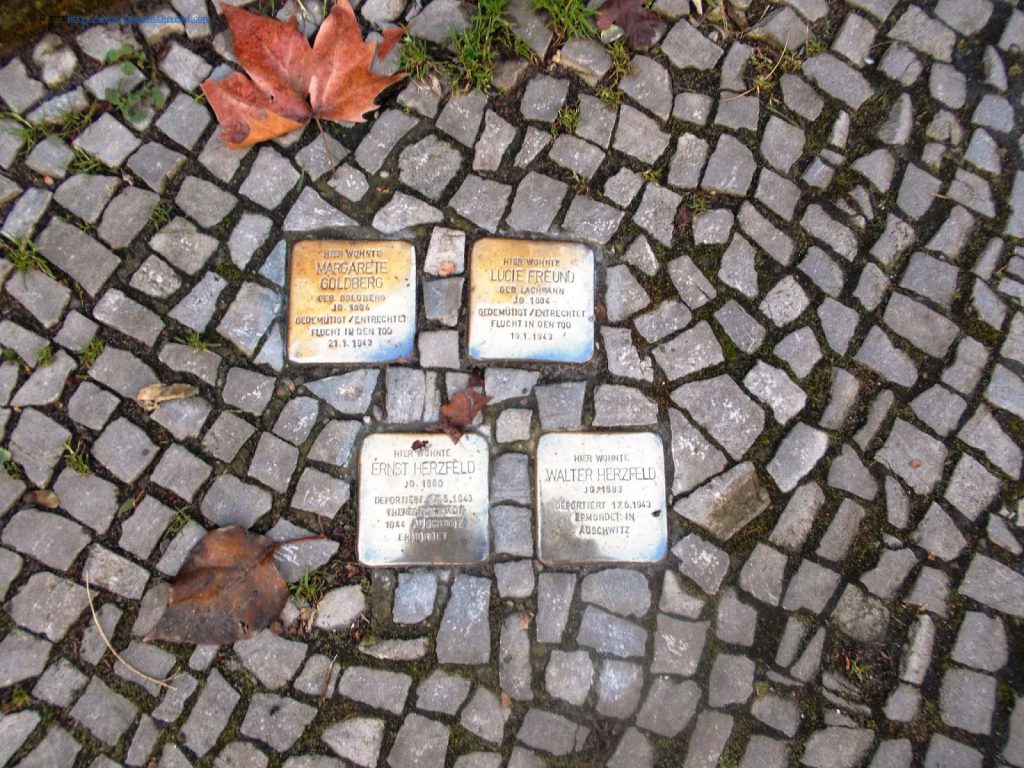
On a more modest scale, in the “Bavarian quarter” of Schöneberg, eighty panels have been applied to the lampposts that recall the successive steps the Nazis took in their persecution of the Jews. Mingled with these chilling historical facts are extracts of letters written by inhabitants of the neighborhood who were deported.
Throughout the city as a whole, commemorative plaques attest to a vanished Jewish lifestyle: in Steglitz, for example, the names of the 3186 Jews living in the area in 1933 are engraved on a mirrored panel measuring approximately 12.5 ft. wide x 40 ft. long.
After long debates, on 25 June 1999 the German Bundestag accepted a motion to erect a monument in memory of the Shoah near the Brandenburg Gate. The realization of this project was entrusted to the American architect Eisenman. It is composed of 2700 concrete pillars of varying heights and contain at its center information about the persecution of the Jews under Nazism.
In contrast to the contemporary initiatives to preserve the pre-World War II Jewish cultural heritage, the most ancient evidence of a Jewish presence in Berlin has been erased. Whether by the fires that ravaged the large village in its early days, the periodic attacks on the Jewish population, or finally the torments of the Second World War, the oldest traces of the Jews had been proven to date from 1295 (only sixty years after the founding of the city) have disappeared.

The Topography of Terror Foundation has been installed in the primary locations where the Nazi terror machine (the Gestapo, Reichsführung SS, Sicherheitsdienst) formerly had its headquarters. This institution, federally financed and supported by the State of Berlin, allows visitors to familiarize themselves in situ with how the Nazi state functioned. Awaiting its permanent home designed by the Swiss architect Peter Zumthor, the foundation organizes outdoor exhibitions and guided visits to the quarter.
The Anne Frank Center pursues the same educational aims as the Anne Frank House in Amsterdam, but with a vision oriented more toward adolescents, high school students, and college-age visitors. The Anne Frank Centre offers various travelling exhibitions that enable projects to be carried out in many German cities, helping them to share the history of the Holocaust in an educational way.
Central Berlin
Until 1989, the historic center of Berlin was situated in the former German Democratic Republic, (GDR) separated by a wall from the western part of the city since 1961. Central Berlin was the site of the palace of Frederick II (the Great) and Prussian political and economic activity. The first synagogue in Berlin was erected in this quarter in 1714 (on Heidereuterstrasse, today called Rosenstrasse). Although spared the ravages of Kristallnacht because it had been requisitioned by the German postal service, it was completely destroyed by the bombings of 1945.
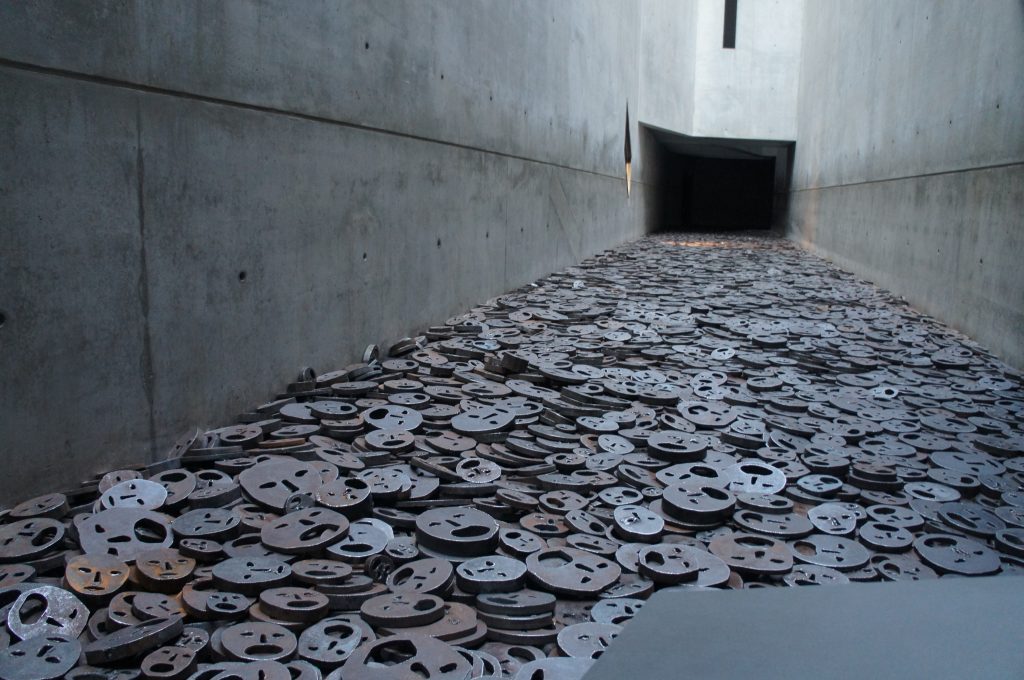
Orianienburgerstrasse was not properly a “Jewish quarter” since the number of Jews who lived here never grew grew beyond 10% of the Jewish population in the city overall.
During the Prussian Empire and the Weimar Republic, this centrally located Berlin street and neighboring arteries were a gathering point of Jewish immigrants from the east. These Jews, with their caftans, long beards, and earlocks, were thus more visible than their assimilated German counterparts. The restoration of this quarter, and notably the Grand Synagogue, is almost complete.
Opened in 1866, the Grand Synagogue was designed by the architect Edward Knoblauch in te Moorish style so fashionable at the time. With its 164 foot gild dome and its capacity to serve 1800 faithful, the Grand Synagogue gave the opulent Jewish population in Berlin a reason to be proud.

The synagogue escaped damage in the violence of Kristallnacht on 9 November 1938 thanks to the courageous action of a brigadier police officer, William Krütfeld, who, with several other men, managed to make the hordes of SA withdraw by pretending that the synagogue had been placed under police protection due to the riches it contained. Closed by the Nazis in 1940, the synagogue was transformed into a warehouse. It was seriously damaged by a bombing in 1943.
In a effort to change its image in the eyes of Israeli Jews, the GDR began the renovation of the synagogue and construction of a Jewish community center nearby in the late 1980s. While not all of them are kosher, the cafés and restaurants surrounding the synagogue offer drinks and traditional dishes typical of the Eastern European Jewish kitchen mingled with highlights from Israeli cuisine. At the Jewish Gallery , paintings are displayed by Jewish artists hailing mostly from the former Soviet Union, as well as religious objects, both old and new.
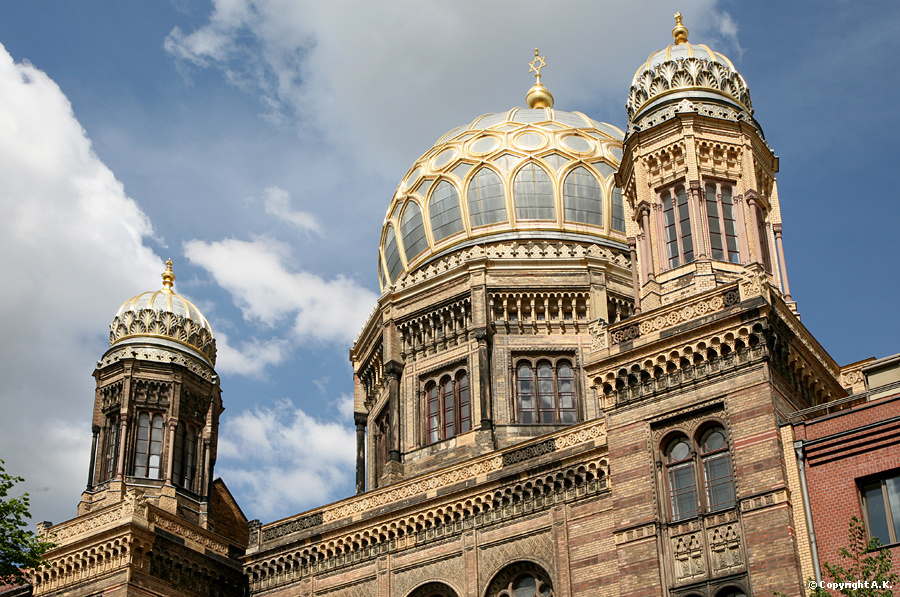
Completed in 1765, the Ephraim Palace belonged to financier Veitel Heine Ephraim (1703-75), the banker of Frederick the Great. Demolished during the major urban renewal efforts of 1935, the rococo facade was nevertheless saved and later protected from the bombings. In 1987, the facade was reassembled during the renovations of central Berlin undertaken by the GDR. The palace today houses an annex of the Museum of Fine Arts that contains, most notably, a collection of ancient coins.
Charlottenburg-Wilmersdorf
Charlottenburg-Wilmersdorf is the heart of the former West Berlin, whose principal thoroughfare is the Kurfürstendamm. The administrative center for the Jewish community in Berlin is located here with its social and cultural institutions.
Klezmer in Berlin
In East Berlin, before the fall of the Wall, a few young musicians began, in a provocative effort, to play klezmer music, a mixture of Jewish music from Central Europe and American jazz originating from the encounter between these two musical styles in the Jewish neighborhoods in New York. This music, underground during the Communist era, has become very popular in Berlin. The Theater in den Hackeschen Höfen offer klezmer concerts almost every Monday evening and Saturday evening.

The synagogue on the Pestalozzistrasse was built in 1912 at the initiative of Betty Sophie Jacobson, a wealthy businesswoman in the neighborhood. On the night of 9 November 1938, the synagogue was set afire and might have burned to the ground, had firemen not quickly extinguished the flames fearing that they would spread to nearby buildings. The interior of the synagogue thus suffered only minor damages and could be reopened as early as 1946. The services there are celebrated according to the liberal liturgy with a mixed choir and organ musicis a former meeting hall of the B’nai Brith. Now Orthodox services are celebrated here.
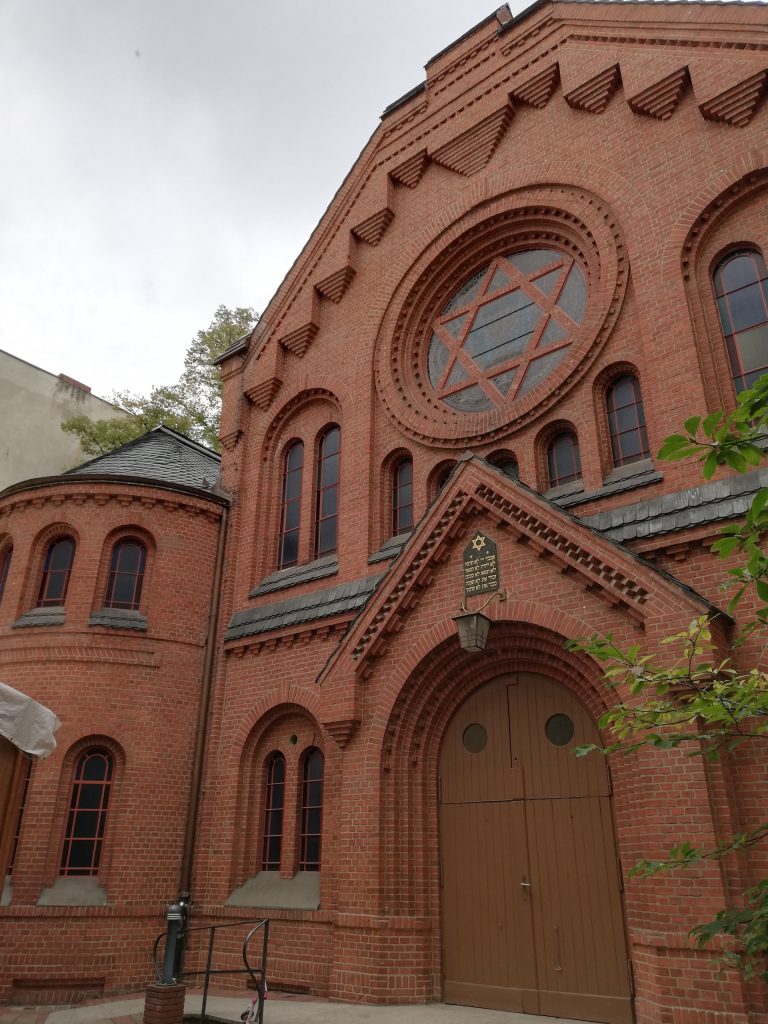
The Jewish Museum Berlin contains a permanent exhibition on the history of Berlin’s Jews and houses the collection of objects, religious and secular, that were contained in the former Jewish Museum, a private institution in existence until 1938. This museum is remarkable above all for its metaphorical architecture, designed by Daniel Libeskind. The metal facades, torn in shreds, powerfully evoke the abuse and victimization the museum has suffered.
The cemetery on Schönhauserallee , established in 1827, contains the graves of the personalities who animated the cultural and economic life of Berlin at the end of the nineteenth and beginning of the twentieth centuries, personalities such as the bankers Gerson von Bleichröder and Joseph Mendelssohn, the musician Giacomo Meyerbeer, and the painter Max Liebermann.
With its ninety-nine acres of land, Weissensee if one of the largest Jewish cemeteries in Europe. Established in 1880 and devastated during the Second World War, it was renovated little by little by the authorities of the GDR and the reunification accelerated this rehabilitation. One finds here the graves of eminent Jewish personalities from prewar Berlin: the philosopher Hermann Cohen, the theologian Leo Baeck, the editor Samuel Fischer, and the heads of the press Theodor Wolff and Rudolf Mosse.
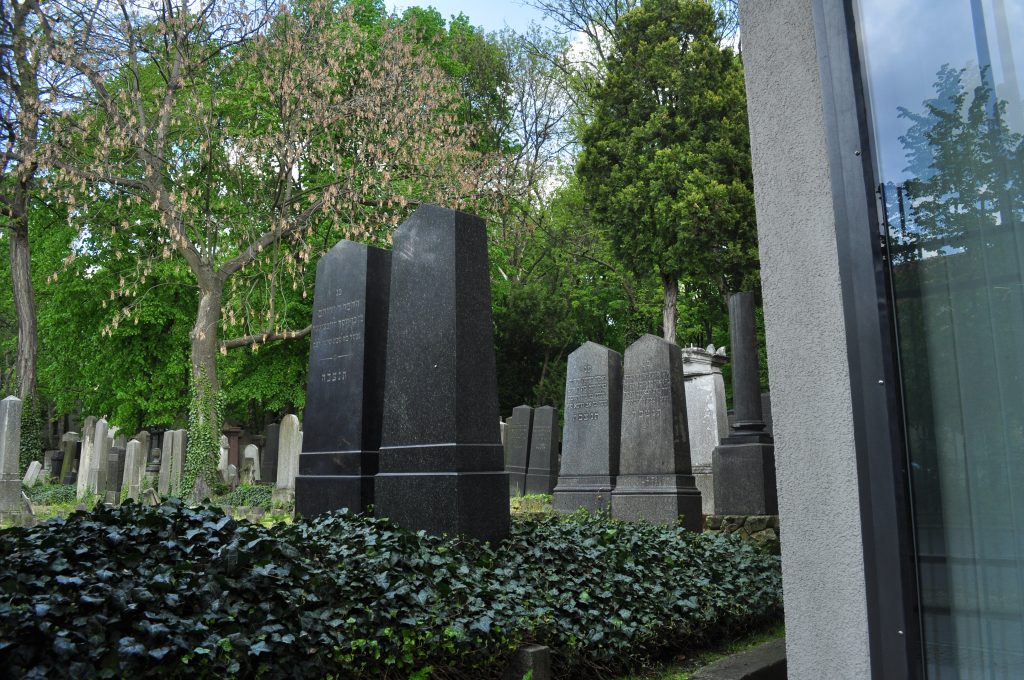
The Literaturhandlung is the most important Jewish bookstore in the whole of the German-speaking community (with satellite stores in Munich and Vienna). You can find items for religious worship here (mezuzot, candelabra, prayer shawls, etc.), as well as greeting cards for the Jewish holidays. Also interesting to visit, the Omanut gallery .
Cafés and restaurants certainly are not lacking in this area. Salomon’s Bagels is a minuscule shop devoted to bagels, or according to the owner of the place, Andreas Pfeffer, “edible wisdom”.
In 2025, the Jewish community of Berlin has more than 10 000 members, making it the largest in the country. As a sign of the rebirth and development of Berlin’s Judaism, a synagogue is being rebuilt on the site where it was destroyed during the Holocaust, in the Kreuzberg district. It should be inaugurated in 2026 by Beate Hammett, the daughter of Alexander Beer, the architect responsible for building the original synagogue.
On 11 November 2025, the Neue Synagoge Berlin – Centrum Judaicum foundation celebrated the 30th anniversary of the opening of the Centrum Judaicum in the partially rebuilt New Synagogue on Oranienburger Straße. Around 200 guests from the worlds of politics, culture, science and society attended the anniversary ceremony on 11 November 2025. The ceremony paid tribute to the history of the building and to the people who have shaped its development over the past three decades. As in many other cities with large Jewish communities, Berlin has seen a sharp increase in anti-Semitic acts since the pogrom of 7 October.